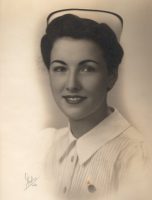Editor’s note: This is an early release of a web exclusive article for the April 2021 issue of American Nurse Journal.
At the bottom of the article, the authors and Jean Watson share more about their work in a brief video.
Takeaways:
- Despite unprecedented stress and uncertainty during COVID-19, nurses remain focused on caring for colleagues, patients, and significant others.
- Self-care enables genuine caring for others.
- Simple micro-practices facilitate genuine caring for self and others without adding to existing time stress.
Ten insights inspired by nurse narratives
Healthcare environments have been preparing, shifting, transforming, and emergently responding to the COVID-19 pandemic since March 2020. Nurses have provided care during uncertainty, long hours, constantly shifting work environments, and expanded or new professional roles. Work-related stress—and distress—have been reported in the media and on social networking sites. Formal knowledge development is underway to better understand nursing challenges during this ongoing global crisis.
In September 2020, a free massive open online course (MOOC) entitled “Caring science, mindful practice” provided an opportunity for nurses in various settings, at all practice levels to share thoughts and experiences about what it means to care in their respective roles. The course’s content and learning activities don’t mention the current COVID-19 pandemic, but 97 discussion board posts referenced it during the session. This article presents 10 insights gleaned from those postings with accompanying simple practices (micro-practices) that nurses can do anytime, anywhere to cultivate caring for self and others.
The course
The noncredit 4-week “Caring science, mindful practice” MOOC was created and is taught by nurses. It runs twice a year and is free to anyone, anywhere with access to the internet. The course provided an outlet for learners to explore and discuss their experiences of caring and to provide simple micro-practices that support caring for self and others at work and beyond. Watson’s Human Caring Theory, which contends that caring is the core of nursing practice, forms the foundation of the course’s content. This theory acknowledges that authentic caring for self, colleagues, and clients requires conscious and ongoing cultivation of a firm intent to holistically care in all moments and situations.
At the beginning of the course, learners are introduced to Watson’s theory and Thich Nhat Hanh’s simple mindfulness practices. Watson is a nurse theorist who teaches caring science to nurses and allied healthcare professionals around the world. Thich Nhat Hanh is a Zen Buddhist monk, global spiritual leader, founder of Plum Village Monastery, peace activist, and poet who teaches simple mindfulness practices to people of all faiths.
Throughout the course, learners can share their experiences in a series of open asynchronous discussion boards where they and moderators create a safe and supportive digital caring community where all voices are honored and celebrated. Participants share experiences, insights, and collegial support using reflective narrative, contemplative art, and interactions with others. In addition to web links, video lectures, slide presentations, and instructional materials, a textbook is available but isn’t required.
The course explains how caring moments radiate beyond specific situations (moving through space, time, and the physical plane) to create endless possibilities of caring influence, teaches that self-care enables authentic caring for others, and demonstrates how to use Watson’s 10 Caritas Processes to facilitate authentic caring. “Caritas” means love and compassion for humankind, including self and others. (See Human caring framework.)
Human caring framework
The framework of Watson’s Human Caring Theory includes the 10 Caritas Processes.
- Practice lovingkindness with self and others.
- Instill faith, hope, and honor for self and others.
- Be sensitive to self and others by nurturing individual beliefs and practices.
- Establish trust through mindful and authentic presence.
- Promote and accept positive and negative feelings through authentic and unbiased listening and sharing.
- Use creative scientific problem-solving, along with all ways of knowing, to engage in caring decision-making.
- Engage in teaching and learning moments that address individual needs and comprehension styles.
- Create healing environments that respect human dignity.
- Treat the process of assisting with basic physical, emotional, and spiritual needs as a sacred act.
- Be open to mysteries and miracles.
Two discussion boards per week provide opportunities for participants to share experiences, observations, feelings, insights, and epiphanies related to the caring and mindfulness basics presented in course content.
The course has been offered twice a year since 2015. To date, 5,374 people have registered for the course and 1,356 completed 80% or more of the content to earn certificates of completion. The average overall course effectiveness rating for all sessions is 4.7 out of 5 stars. The September–October 2020 session, which had 242 registrants (123 successfully completed the entire course), contained the postings reviewed for this article. About 78% of the participants were nursing students and nurses from a broad range of practice areas, educational levels, and job titles. The other 22% included physicians, healthcare administrators, allied health professionals, and others with an interest in learning about and practicing professional caring in areas outside of healthcare.
10 insights
This knowledge development endeavor was classified as Institutional Review Board (IRB) exempt. After several reviews and mindful consideration, we chose 10 insights that we believe capture the tone, wisdom, and common sentiment of the nurses who shared their thoughts and experiences. (See Caring insights.)
Caring insights
After carefully reviewing participant thoughts shared in the “Caring science, mindful practice” massive open online course discussion boards, we selected 10 insights that encompass nurses’ experiences during the COVID-19 pandemic.
| Insight | Quotes |
| Year of the Nurse highlights the critical role nurses play in human caring. | · Through this course I kept thinking about how the soul of nursing is hurting right now. The care of patients with COVID-19 crushed the feelings of hope and the ability to see miracles. Our units saw more patients die in a day than we would in a week pre-COVID… Many of our nurses are leaving critical care and some left the bedside completely. This is not unique to us, you read about the same thing happening across the world. The Year of the Nurse will be the year that nursing is reborn. Nurses need to find that resiliency and strength to provide care in our world now. The [Caritas Touchstones] are about resiliency and finding the inner strength…I am going to share this on our units. · A personal experience that I can relate to this process is the collective experience of working in a COVID-19 [intensive care unit (ICU)] full-time for the past 6 months. Not a day goes by that I don’t wonder when, and sometimes if, we will get back to having families at the bedside to support dying patients. In these trying times, I’ve developed a strong awareness of my role in this process. I’ve come to the realization that now more than ever. I can use my ability to connect with patients and families like never before. · The profession of nursing is well known for being trustworthy and dedicated to those it serves. In the year 2020, those principles have remained the same as COVID-19 pushed the field of nursing back into the limelight for its dedication…I know from personal experience that often you get more than you give in this field. It truly is humbling to witness and provide comfort on what is often considered someone’s worst day…Nurses have often been referred to as the heart of the hospital because of that innate ability to be present and care for clients on every level—spiritually, emotionally, and physically. |
| Self-care enables authentic caring for others. | · With implementation of self-care, nurses are able to provide positive and supportive experiences for their patients while also being mindful of self. Self-care involved in nursing practice can include meditation, therapy, massage, or reading. These activities engage the mind to process what was experienced during their shifts and release energy to enter a new day with a refreshed sense of self. · As a leader, I have a vast responsibility of providing a caring environment for my staff, but in order to do so I have to be able to care for myself. Pre-COVID-19, I decided to get a trainer and had been exercising 2 days a week before work. I did feel better, but did not think much of the process until I was not able to do that anymore. I think that the reason why nurses are stressed, burnt-out, etc. is because we do not practice mindfulness and self-care, therefore we are not able to provide sustainable care for our patients. · When you are functioning daily on limited sleep, hectic schedules, and high stress levels, it is very easy to become overwhelmed during the best of times. Working with COVID-19 patients adds a whole new level of stress to the situation. Taking time to remember myself and my needs has become crucial and has allowed me to nurture my mental health and keep my focus on what truly matters to me. Making time to practice self-care has allowed me to still love my work and show up for each shift with a smile on my face and positive attitude, which allows me to care for my patients with an open heart, an understanding mind, and a hopeful spirit. |
| Simple mindfulness practices can meaningfully impact the ability to care. | · Thich Nhat Hanh’s teachings and Watson’s Caring Moment [when authentic human-to-human caring is palpable in the moment] resonate with each other because they both focus on the awareness of the interconnectedness with each other. Thich Nhat Hanh speaks of “surrendering yourself to the present moment,” which is directly connected with Watson’s Caring Moment by focusing on the present moment when we can exchange that interpersonal moment. In each of their teachings, the present moment is where time, space, and physicality are all transcended into a unique personal experience. One instance when I felt that mindful caring practice influenced my work was in the hospital recently. COVID-19 has drastically affected patients’ emotional stress. Not allowing family or visitors to enter the facilities leaves patients feeling depressed, anxious, and stressed. I had a patient [with many complaints] who [had significant stressors in addition to being hospitalized]. I asked her what she was grateful for and if she had a good support system. As we talked, we came up with some ways [to] cope with her stress and sadness. The patient’s attitude for the rest of the day was lighter…Instead of being frustrated and annoyed with her constant complaining, I listened. I realized that my attitude towards her negativity was what changed the situation. It gave her the opportunity to tell someone what the real complaint was. Very freeing and rewarding experience for me and her. · It’s easy to get caught up in the tasks and forget that there is an actual human you are in charge of caring for…When COVID-19 first came about it was a very hectic time in the hospital, it was a learning curve for everyone, and a constant changing environment in which we were all working. I was working in the COVID-19 unit of the [emergency department] and a patient came in with confirmed COVID-19. The patient was not doing well at all, needed one-on-one care, and was quickly deteriorating. The easy route for handling this was just to do my job, do the appropriate tasks, and move on to the next patient. What I chose to do was be present, gowned up, N95 on, face shield on, completely present for this patient, and listen to him as he spoke with the breath that he had…I felt so many emotions in this moment, not only could this man hardly see my face, but he knew that he was not doing well. Being present allowed me to care better for this man, I was able to use my faith that has been instilled in me to be strong and not overly emotional in front of the patient to be even more present. I was able to provide hope for him in the moment and show him that I cared and was there to honor him and his wishes…This was an overwhelming experience for me but I was reminded just how amazing being present can be. |
| True listening supports true caring. | · Of late, with several competing factors, COVID-19 included, I find myself always rushing and not always spending the time with staff as before. Staff will try to speak with me, and it always seems that I am making excuses… After reading the chapter on the fifth caritas [promote and accept positive and negative feelings through authentic and unbiased listening and sharing], I have made a conscious decision to be a more active listener. My goal is to treat everyone as if they are the most important employee. When staff need to speak, they should be allowed the opportunity to be heard. I do not believe that they want to hear excuses or that what I have to do matters to them. Recently, after reading this chapter, a nurse stopped me at the elevator and wanted to speak to me. At first, I was about to make an excuse but then I decided to make the time to speak to her. She shared some personal struggles and wanted advice on how to move forward…She later thanked me for taking the time to listen. · I spoke to a student yesterday who is struggling. I wanted to jump to help her solve any knowledge gaps to get her prepared for the exam. She was a little startled by my approach, I sensed this, softened my tone, and just let her talk…I needed to listen to her struggles and even her complaints…first. I had to hear her express her feelings and not judge them or take them personally. I…received an email this morning thanking me for my kindness. · There have been many instances where we have to look at the whole situation and try to really listen to one another rather than making assumptions and sometimes it takes one to just be quiet, observe, and ask questions that will help clarify the thought process when/how and why things are done. |
| Authentic presence promotes caring connections. | · These teaching[s] are essential and I also try to self-reflect difficult situations where I felt I might have not been authentically present because I was distracted with something else and it helps me understand myself better so I can be there for others. I truly enjoyed the guided imagery exercise of the clouds and sunflower exercise in the video session, it helped me not engage in negative thought. Thank you for this learning. · People helping people more and being present for those who are alone and fighting for their lives has become more commonplace. When nurses choose to do nursing and work somewhere that is one thing, but how they react to working with patients they may not care to work with under difficult situations [is when] true colors prevail. That both patients and their families could experience each other virtually due to the caring actions of others is a gift. When we see these actions, we are lifted up and know that we are blessed by the presence of something truly wonderful. · At the height of COVID-19, we lost several patients in the ICU. At the time, families were not allowed at bedside. In a similar situation, I watched as one of my good friends and colleagues provided emotional support. Her patient was terminally weaned (taken off the ventilator and made comfortable). As I looked in the room, I could see my friend in full [personal protective equipment], sitting and holding the hand of her patient. She made sure this patient was not alone and [was] loved during her final moments. |
| Re-centering facilitates caring focus. | · As I myself started to let the fear and anxiety of COVID-19…shake my core, I decided I had to center myself first and then set out to reconnect with my staff. I started by focusing on gratitude and wanting to spread joy to the people I cared for. I reached out to others and let them know I was grateful for our friendship and I was there for them if they needed to talk. I [watched] cute animal videos that helped me reconnect with the beauty of life and nature and forwarded them on to my colleagues who I knew were also struggling at this time. It may seem as something small and ridiculous, but it helped me focus on things that brought me joy and helped bring positivity back into my life rather than focusing on the things that I can’t control and the fear of the unknown. · This course has been very practice changing for me. It has helped to truly realign me with the things I believe in and values that I possess. I am grateful for the opportunity to share experiences that I have witnessed or been a part of. I feel as though my mindfulness and caring practice have been reset, which will allow me to be more patient-centered and focused when caring for my patients…I was in a place where I was feeling burnt-out between working, dealing with COVID-19 at work, management changes,…and just life being overwhelming in general…This course came along at a perfect time to re-center my beliefs and allow me to focus on the true idea of caring for a patient and not just attending to the medical needs at hand, focusing on the patient and their support system as people. |
| Lovingkindness towards self and others cultivates enduring compassion. | · I see compassion and lovingkindness for others every day when I make my rounds and see the staff in my departments caring for patients. It might be helping a post-op patient FaceTime with their family since no visitors are allowed in our facility due to COVID-19. It’s evident and present when I see a nurse with a cold washcloth on the forehead of a… patient…who just vomited. It’s present when I see the staff covering up the patient to maintain their dignity before they are wheeled through the corridors of the hospital…It’s present when the unit secretary pays for the…prescription for [a] patient who is being discharged home and says they don’t have any money to cover the cost. It’s hugging the nurse to comfort her when she talks about her ill family member…seeing everyone in the department surround her with lovingkindness was so awesome! · The best example of nursing expressing compassion, valor, joy, and pain are the nurses [caring for COVID-19 patients]. The uncertainty of virus effects on the human body, the fear of wearing the proper protection device correctly, and anxiety of sharing the virus with family. They return day after day to do everything in their power to provide care, reduce suffering, and [give] emotional support to [the] patient by letting them know “you are not alone”.…Their primary focus was to provide patient-centered care in the most compassionate caring way the disease allowed them. · As nursing is going through its transformation during the COVID times, it really brings out the importance of true healing and caring moments when we are connecting with our patients or team with openness, love, and compassion. |
| Human connection arising from a firm intent to care provides comfort to both self and others. | · Even though some patients may be harder to connect with than others, these patients need human connections now more than ever. As nurses, we can make a meaningful impact on our patients’ experience in the hospital by forming a genuine connection with them. You never know when one of these so-called “difficult” patients may be really touched by the impact of how much we show a caring attitude towards them. · I can relate to your post about making time for caring interaction in the chaos. Nursing is often a busy, intense, chaotic practice. Finding time for personal connections and listening to a patient’s concerns is as important as administering the medications. I find I crave those connections, especially on the most busy and chaotic nights. We, as caregivers, benefit from that touch as do the patients. |
| Appreciation and joy support hope and meaning. | · As our research and methods around COVID-19–related workflows are changing, it’s causing lots of fatigue, burn out, and anxiety around teams to be able to keep up with these changes. To help build resilience and bring joy and mindfulness in our practice, we implemented share a story on what brings joy in one’s shift in our huddle practice. This practice allowed team [members] to express themselves and share their stories related to patient encounters of a caring moment, situations where they felt it was challenging, and for all present members to support one another. We continue to have a session around this weekly to help bring purpose and joy in our practice. · I think your story is a moving tribute to those who work hard to make life better for others and I think something as devastating as the COVID-19 infection has made many feel vulnerable for themselves and for others. |
| Intentionally created communities of caring are important and necessary for nurses to flourish.
| · Initial post: This is a mandala I created to represent the care of the elderly. Working as a nurse in a long-term care facility, the 9th caritas [treat the process of assisting with basic physical, emotional, and spiritual needs as a sacred act] spoke to me. The residents depend on the staff to meet their most basic needs. The cracks in my drawing depict the frailty of life and the hearts represent the staff who embrace this caritas; they have compassion for someone else’s loved one. Especially during these times, in combatting the coronavirus, nurses and caretakers have fulfilled the most basic need of love and companionship for these long-term care residents during quarantine. This is a vivid and harsh memory I will carry with me the rest of my nursing career as a reminder of how fragile life is and how I would want my loved ones cared for in my absence. · Responses to the initial post: o I can see how your mandala relates to the caritas you spoke of. During the COVID-19 pandemic I have seen more and more elderly community members coming into our department for minor complaints that could have been easily addressed; [however], many of them feel that they are not able to connect with their care providers as easily as they had previously and this has increased their sense of anxiety related to their conditions. I have also found that many of them report increasing loneliness due to lack of normal family interactions and this has also increased their anxieties surrounding their chronic conditions. During interactions with most of the elderly patients, I am constantly attempting to create a sense of safety and companionship in our department so that they feel less of the burdens from this pandemic. o I love the representation of the picture. Immediately before reading [the explanation], I knew what the picture represented. During the beginning of the COVID-19 pandemic, families were not allowed to visit their loved ones while they were admitted in the hospital. You could see the sadness and fear of both the patient and their families. We as nurses had to take on the job of the nurse and their families. Showing them love and compassion a little more than normal because a piece of them was missing. o I love the mandala and the way that the cracks represent broken pieces of who we are, especially when we are most vulnerable and needing the care and concern of others. I cannot imagine what this virus has done to those who have suffered from the disease, the effects of the loss of loved ones, and the essence of those who remained to give their best compassionate care. Compassion is using our small tasks that seem fairly meaningless as a time to express our love and concern for others. Every small kindness blessed those who were the receivers, but also the givers. You have taken an incredibly difficult time in people’s lives and drawn the difficulty and the beauty, but mostly the love. Thank you for sharing this mandala. It is amazing how the circle of life works. How fragile life is in general, but especially our needs as humans as we transition into the elderly stages of our life. I can only imagine the amount of emotions your patients must have felt within this past year living through COVID-19. o I love your drawing. It’s creative! It is an excellent representation of care for the elderly. I like how every detail in the picture represents something. For example, the cracks represent the frailty of life, and the hearts represent the staff who embrace this caritas. This picture is an excellent example of the ninth caritas. I agree that the residents depend on the staff to meet their most basic needs because due to COVID-19, family members aren’t allowed in the facility. Therefore, residents rely on the staff to meet that need. o That is a beautiful mandala! In these trying times, our caring and humanity are essential. We have become the family, friend, and caretaker all at once. o This is beautiful and your explanation of connecting this image to care for the elderly is moving. I agree completely how life is so sacred and fragile. |
Micro-practices
Micro-practices are introduced throughout the course to help learners envision how to fit caring and mindfulness prompts into their busy and hectic lives. Learners consistently report that these brief and simple micro-practices are powerful tools that improve nurse and patient experiences in a variety of situations. Learners also share their own micro-practices for the benefit of all participants. Three caring micro-practice favorites from the course include “Three mindful breaths to pause and re-focus,” “Blue sky, white clouds visualization for handling positive and negative emotions,” and “Caritas Touchstones for daily practice.”
Three mindful breaths to pause and re-focus
Some say that the breath is a crossroad between physical and spiritual, and that the small pause between inhalation and exhalation provides a portal for the mind, body, and spirit to enter into deepened awareness. Taking a few moments for three mindful breaths provides a brief respite and an opportunity for renewed focus.
Plant both feet firmly, whether you are sitting or standing, and draw your attention inward. Breathe in, pause and feel the small pulse of awareness, exhale. Breathe in, pause and feel the small pulse of awareness, exhale. Breathe in, pause and feel the small pulse of awareness, exhale. Now turn your renewed awareness outward and continue your day.
The simple pause between each inhalation and exhalation with its portal to calm awareness serves as an ever-present companion. Breathing is a golden thread that binds all of us to the same life force, because the air we breathe is always shared, ebbing, flowing, moving in, around, and through. It’s an almost imperceptible dance of connection in time, place, and circumstance. The air is invisible, but it’s integral to existence. Every breath is a miracle—a mostly involuntary, taken-for-granted, yet profoundly miraculous sharing of collective awareness and life force; a miracle in plain sight. It is available anytime, anywhere, to anyone.
Download an MP3 of the breathing visualization here.
Blue sky, white clouds visualization for handling positive and negative emotions
Emotions come and go, changing from moment to moment. It is easy to get attached to them as if they’re something substantial, unchanging, and enduring. This attachment can cause ongoing pain and discord within and around us. In reality, emotions are as insubstantial as clouds in the sky. This visualization is a brief reminder that none of us are our feelings. After completing this visualization a few times, just taking a few moments to envision a clear blue sky with passing clouds can be enough to reframe difficult situations where challenging emotions are prominent.
Please ground yourself by firmly planting your feet or sit bones to the floor. Breathe in and bring your awareness to your physical body. Squirm and adjust until you feel just right and then settle into calm repose. Inhale, pause, exhale. Close your eyes and envision the blue sky. Your calm, unperturbed core essence is the blue sky. Breathe in the fresh, cool sparkling air in the clear blue sky that is the true “you.” Now envision a few puffy white clouds drifting by in the sky of your mind. Reach out to grasp a cloud. Its cool mist floats between your fingers and your hand comes up empty. Inhale, pause, exhale. Clouds represent the many feelings that pass by your blue core essence. Clouds look solid and substantial, but if you reach out to hold onto a cloud, it is impossible to grasp. It is the same with feelings. They continually go by in the calm blue sky of your mind, impermanent, always moving, changing, dissipating, and reforming. Feel the cool dampness as they roll by. Acknowledge the flow of clouds and note that as they move, reform, and move again, your blue sky core essence remains unperturbed. Appreciate each cloud for what can be learned from its passing without trying to fruitlessly hang on to any one cloud. Whether it is negative or positive, none are permanent or graspable. Just as blue sky is not made of clouds, you are not your feelings. Inhale, pause, exhale. Envisioning feelings as white clouds floating by your brilliant blue core essence allows for freedom to experience emotions, to grow and learn from them, without the stress of trying to hang on to or keep something that was never meant to be permanent. Inhale, pause, exhale. Envisioning feelings as clouds helps to keep the expression of positive and negative feelings within perspective. Inhale, pause, exhale. Bring your attention to your feet or sit bones. Inhale, pause, exhale. Slowly open your eyes and stretch.
Download an MP3 file of the blue sky, white clouds visualization here.
Caritas Touchstones for daily practice
The Caritas Touchstones can be printed on an index-sized card and carried in a pocket for easy reference throughout the day. They contain brief prompts to facilitate caring for self and others during the beginning, middle, end of your work day—and beyond.
- Caring in the beginning:
- Begin the day with silent gratitude; set your intention to be open to give and receive all that you are here to give and receive this day; intend to bring your full self in the day-to-day moments of this day; cultivate a loving, caring consciousness toward yourself and all others who enter your path.
- Caring in the middle:
- Take quiet moments to “center,” to empty out, to be still with yourself before entering any new situation; cultivate a loving-caring consciousness toward each person and each situation you encounter throughout the day; make an effort to “see” who the spirit-filled person is behind the client or colleague.
- Return to these loving-centered intentions again and again throughout the day to remind yourself why you are here.
- In the middle of stressful moments, remember to breathe; ask for guidance when unsure, confused, and frightened; forgive and bless each situation.
- Let go of that which you cannot control.
- Caring in the end
- At the end of the day, fold these intentions into your heart; commit yourself to cultivating a loving-caring practice for yourself.
- Use whatever has presented itself to you this day as lessons to teach you to grow more deeply into your own humanity and inner wisdom.
- At the end of the day, offer gratitude for all that has entered the sacred circle of your life and work this day.
- Bless, release, and dedicate the day to a higher, deeper order of the great sacred circle of life.
- Caring continuing
- Create your own intentions and authentic practices to develop your caritas consciousness (find your own unique spiritual path in support of this work).
Download an MP3 file of the Caritas Touchstones practice here.
An open invitation
The insights, quotes, and micro-practices presented here have validated and supported caring intent for nurses within the “Caring science, mindful practice” MOOC. We invite you to join us in future course sessions where you’ll have opportunities to share your own insights and observations about COVID-19 in a safe, sacred, supportive space. For more information about how to sign up for the course, visit caringsciencemindfulpractice.com and click the “Free online education” tab.
Editor’s note: “Three Mindful Breaths to Pause and Re-focus,” “Blue Sky, White Clouds Visualization for Handling Positive and Negative Emotions,” and “Caritas Touchstones” audio reading are used with permission of Kathleen Sitzman. “Caritas Touchstones for Daily Practice” text is used with permission of Jean Watson.
Kathleen Sitzman is a professor and Distinguished Watson Caring Science Scholar at the College of Nursing at East Carolina University in Greenville, North Carolina. Ileen Craven is a clinical nurse specialist in medicine at Vidant Medical Center in Greenville, North Carolina.
Reference
Sitzman K, Watson J. Caring Science, Mindful Practice: Implementing Watson’s Human Caring Theory. 2nd ed. New York City, NY: Springer Publishing Company; 2018.
In the video, the authors and Jean Watson share more about their work.


















